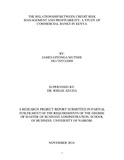The relationship between credit risk management and profitability: a study of commercial banks in Kenya
| dc.contributor.author | Muthee, James G | |
| dc.date.accessioned | 2012-11-13T12:37:29Z | |
| dc.date.available | 2012-11-13T12:37:29Z | |
| dc.date.issued | 2010 | |
| dc.identifier.uri | http://erepository.uonbi.ac.ke:8080/handle/123456789/5749 | |
| dc.description.abstract | Banks operate in an environment of considerate risks and uncertainty. Credit risk has always been a vicinity of concern not only to bankers but to all in the business world because the risks of a trading partner not fulfilling his obligations in full on due date can seriously jeopardize the affaires of the other partner. Credit risk management in banks has become more important not only because of the series of fmancial crisis that the world has experienced in the recent past but also the introduction of Basel II accord. Managing credit risk thus remains an essential and challenging corporate function. The chief goal of an effective credit risk management policy must be to maximize a commercial banks risk adjusted rate of return by maintaining credit risk exposure within acceptable limits. Moreover banks need to manage credit risk in the entire portfolio as well as the risk in individual credit or transactions. The objective of the study was to establish the relationship between credit risk management and profitability in commercial banks in Kenya. Both qualitative and quantitative methods were used in order to fulfill the main purpose of the study. A regression model was used to do the empirical analysis. In the model ROE was defined as the profitability indicator while NPLR as credit risk management indicator. The primary data was collected through a structured questionnaire; the information was analyzed with the help of descriptive statistics. The secondary data was collected from the published annual reports for the commercial banks for a period of ten years. The findings and analysis reveal that credit risk management has effect on profitability in all the commercial banks analyzed. NPLR has a significant effect on profitability indicator (ROE). The study used regression analysis to establish the association between NPLR and ROE; a forecasting model was developed and tested for accuracy in obtaining predictions. The finding of the study indicated that the model was moderately significant. NPLR as an independent variable was linearly related with the dependent variable (ROE) thus simple linear regression model was used to forecast ROE for commercial banks; however care should be taken when using the model and where necessary other independent variables should be included in the model so as to strengthen the value of R2. The results obtained from the regression model show that there is an effect of credit risk management on profitability at a reasonable level. Banks should therefore prudently manage credit risk to bolster their profitability levels. The analysis on each bank level shows that the impact of credit risk management on profitability is not the same. In view of these findings, the author recommends that there should be continuous {mandai innovation by commercial banks in Kenya in order to minimize credit risk and boost profitability. in extension this will strengthen the financial system and create more wealth for the shareholders. | en_US |
| dc.language.iso | en_US | en_US |
| dc.publisher | University of Nairobi, Kenya | en_US |
| dc.title | The relationship between credit risk management and profitability: a study of commercial banks in Kenya | en_US |
| dc.title.alternative | Thesis (MBA) | en_US |
| dc.type | Thesis | en_US |

